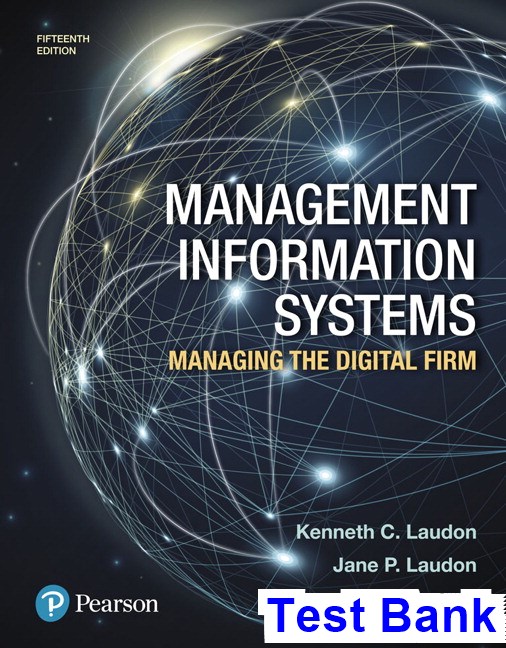Management Information Systems Managing the Digital Firm 15th Edition Laudon Test Bank
$35.00 Original price was: $35.00.$26.50Current price is: $26.50.
Management Information Systems Managing the Digital Firm 15th Edition Laudon Test Bank
Instant download Management Information Systems Managing the Digital Firm 15th Edition Laudon Test Bank pdf docx epub after payment.

Product details:
- ISBN-10 : 9780134639710
- ISBN-13 : 978-0134639710
- Author: Kenneth C. Laudon; Jane Price Laudon
The authoritative, case-based view into how businesses leverage information systems
Kenneth and Jane Laudon’s popular Management Information Systems: Managing the Digital Firm continues to define the way MIS courses are taught. Designed for business students, the text provides insight into how contemporary businesses leverage information technologies and systems to achieve corporate objectives. The new edition provides the most up-to-date and comprehensive overview of information systems used by businesses today, including all-new real-world cases and discussion of significant contemporary topics, from big data and the Internet of Things (IoT) to machine learning and DevOps.
Featuring comprehensive coverage of new technologies and applications, while also considering their impact on business models and decision-making, Management Information Systems enhances learning through vivid examples designed to capture the imaginations of all students. As they build sought-after skills for the modern workplace, students will learn to lead management discussions and drive decisions about their firm’s information systems.
Table of contents:
- Part One Organizations, Management, and the Networked Enterprise
- Chapter 1 Information Systems in Global Business Today
- Learning Objectives
- 1-1 How are information systems transforming business, and why are they so essential for running and managing a business today?
- How Information Systems Are Transforming Business
- What’s New in Management Information Systems
- Globalization Challenges and Opportunities: A Flattened World
- The Emerging Digital Firm
- Strategic Business Objectives of Information Systems
- Operational Excellence
- New Products, Services, and Business Models
- Customer and Supplier Intimacy
- Improved Decision Making
- Competitive Advantage
- Survival
- 1-2 What is an information system? How does it work? What are its management, organization, and technology components? Why are complementary assets essential for ensuring that information systems provide genuine value for organizations?
- What Is an Information System?
- Dimensions of Information Systems
- Organizations
- Management
- Information Technology
- It Isn’t Just Technology: A Business Perspective on Information Systems
- Complementary Assets: Organizational Capital and the Right Business Model
- 1-3 What academic disciplines are used to study information systems, and how does each contribute to an understanding of information systems?
- Technical Approach
- Behavioral Approach
- Approach of This Text: Sociotechnical Systems
- Review Summary
- Key Terms
- Review Questions
- Discussion Questions
- Hands-On MIS Projects
- Management Decision Problems
- Improving Decision Making: Using Databases to Analyze Sales Trends
- Improving Decision Making: Using the Internet to Locate Jobs Requiring Information Systems Knowledge
- Collaboration and Teamwork Project
- Selecting Team Collaboration Tools
- Chapter 1 References
- Chapter 2 Global E-business and Collaboration
- Learning Objectives
- 2-1 What are business processes? How are they related to information systems?
- Business Processes
- How Information Technology Improves Business Processes
- 2-2 How do systems serve the different management groups in a business, and how do systems that link the enterprise improve organizational performance?
- Systems for Different Management Groups
- Transaction Processing Systems
- Systems for Business Intelligence
- Systems for Linking the Enterprise
- Enterprise Applications
- Enterprise Systems
- Supply Chain Management Systems
- Customer Relationship Management Systems
- Knowledge Management Systems
- Intranets and Extranets
- E-business, E-commerce, and E-government
- 2-3 Why are systems for collaboration and social business so important, and what technologies do they use?
- What Is Collaboration?
- What Is Social Business?
- Business Benefits of Collaboration and Social Business
- Building a Collaborative Culture and Business Processes
- Tools and Technologies for Collaboration and Social Business
- E-mail and Instant Messaging (IM)
- Wikis
- Virtual Worlds
- Collaboration and Social Business Platforms
- Virtual Meeting Systems
- Cloud Collaboration Services
- Microsoft SharePoint and IBM Notes
- Enterprise Social Networking Tools
- Checklist for Managers: Evaluating and Selecting Collaboration and Social Software Tools
- 2-4 What is the role of the information systems function in a business?
- The Information Systems Department
- Organizing the Information Systems Function
- Review Summary
- Key Terms
- Review Questions
- Discussion Questions
- Hands-On MIS Projects
- Management Decision Problems
- Improving Decision Making: Using a Spreadsheet to Select Suppliers
- Achieving Operational Excellence: Using Internet Software to Plan Efficient Transportation Routes
- Collaboration and Teamwork Project
- Identifying Management Decisions and Systems
- Chapter 2 References
- Chapter 3 Information Systems, Organizations, and Strategy
- Learning Objectives
- 3-1 Which features of organizations do managers need to know about to build and use information systems successfully?
- What Is an Organization?
- Features of Organizations
- Routines and Business Processes
- Organizational Politics
- Organizational Culture
- Organizational Environments
- Disruptive Technologies: Riding the Wave
- Organizational Structure
- Other Organizational Features
- 3-2 What is the impact of information systems on organizations?
- Economic Impacts
- Organizational and Behavioral Impacts
- IT Flattens Organizations
- Postindustrial Organizations
- Understanding Organizational Resistance to Change
- The Internet and Organizations
- Implications for the Design and Understanding of Information Systems
- 3-3 How do Porter’s competitive forces model, the value chain model, synergies, core competencies, and network economics help companies develop competitive strategies using information systems?
- Porter’s Competitive Forces Model
- Traditional Competitors
- New Market Entrants
- Substitute Products and Services
- Customers
- Suppliers
- Information System Strategies for Dealing with Competitive Forces
- Low-Cost Leadership
- Product Differentiation
- Focus on Market Niche
- Strengthen Customer and Supplier Intimacy
- The Internet’s Impact on Competitive Advantage
- Smart Products and the Internet of Things
- The Business Value Chain Model
- Extending the Value Chain: The Value Web
- Synergies, Core Competencies, and Network-Based Strategies
- Synergies
- Enhancing Core Competencies
- Network-Based Strategies
- Network Economics
- Virtual Company Model
- Business Ecosystems and Platforms
- 3-4 What are the challenges posed by strategic information systems, and how should they be addressed?
- Sustaining Competitive Advantage
- Aligning IT with Business Objectives
- Management Checklist: Performing a Strategic Systems Analysis
- Managing Strategic Transitions
- Review Summary
- Key Terms
- Review Questions
- Discussion Questions
- Hands-On MIS Projects
- Management Decision Problems
- Improving Decision Making: Using a Database to Clarify Business Strategy
- Improving Decision Making: Using Web Tools to Configure and Price an Automobile
- Collaboration and Teamwork Project
- Identifying Opportunities for Strategic Information Systems
- Chapter 3 References
- Chapter 4 Ethical and Social Issues in Information Systems
- Learning Objectives
- 4-1 What ethical, social, and political issues are raised by information systems?
- A Model for Thinking About Ethical, Social, and Political Issues
- Five Moral Dimensions of the Information Age
- Key Technology Trends that Raise Ethical Issues
- 4-2 What specific principles for conduct can be used to guide ethical decisions?
- Basic Concepts: Responsibility, Accountability, and Liability
- Ethical Analysis
- Candidate Ethical Principles
- Professional Codes of Conduct
- Some Real-World Ethical Dilemmas
- 4-3 Why do contemporary information systems technology and the Internet pose challenges to the protection of individual privacy and intellectual property?
- Information Rights: Privacy and Freedom in the Internet Age
- The European Directive on Data Protection
- Internet Challenges to Privacy
- Technical Solutions
- Property Rights: Intellectual Property
- Trade Secrets
- Copyright
- Patents
- Challenges to Intellectual Property Rights
- 4-4 How have information systems affected laws for establishing accountability and liability and the quality of everyday life?
- Computer-Related Liability Problems
- System Quality: Data Quality and System Errors
- Quality of Life: Equity, Access, and Boundaries
- Balancing Power: Center Versus Periphery
- Rapidity of Change: Reduced Response Time to Competition
- Maintaining Boundaries: Family, Work, and Leisure
- Dependence and Vulnerability
- Computer Crime and Abuse
- Employment: Trickle-Down Technology and Reengineering Job Loss
- Equity and Access: Increasing Racial and Social Class Cleavages
- Health Risks: RSI, CVS, and Cognitive Decline
- Review Summary
- Key Terms
- Review Questions
- Discussion Questions
- Hands-On MIS Projects
- Management Decision Problems
- Achieving Operational Excellence: Creating a Simple Blog
- Improving Decision Making: Analyzing Web Browser Privacy
- Collaboration and Teamwork Project
- Developing a Corporate Code of Ethics
- Chapter 4 References
- Part Two Information Technology Infrastructure
- Chapter 5 IT Infrastructure and Emerging Technologies
- Learning Objectives
- 5-1 What is IT infrastructure, and what are the stages and drivers of IT infrastructure evolution?
- Defining IT Infrastructure
- Evolution of IT Infrastructure
- General-Purpose Mainframe and Minicomputer Era (1959 to Present)
- Personal Computer Era (1981 to Present)
- Client/Server Era (1983 to Present)
- Enterprise Computing Era (1992 to Present)
- Cloud and Mobile Computing Era (2000 to Present)
- Technology Drivers of Infrastructure Evolution
- Moore’s Law and Microprocessing Power
- The Law of Mass Digital Storage
- Metcalfe’s Law and Network Economics
- Declining Communications Costs and the Internet
- Standards and Network Effects
- 5-2 What are the components of IT infrastructure?
- Computer Hardware Platforms
- Operating System Platforms
- Enterprise Software Applications
- Data Management and Storage
- Networking/Telecommunications Platforms
- Internet Platforms
- Consulting and System Integration Services
- 5-3 What are the current trends in computer hardware platforms?
- The Mobile Digital Platform
- Consumerization of IT and BYOD
- Quantum Computing
- Virtualization
- Cloud Computing
- Green Computing
- High-Performance and Power-Saving Processors
- 5-4 What are the current computer software platforms and trends?
- Linux and Open Source Software
- Linux
- Software for the Web: Java, HTML, and HTML5
- HTML and HTML5
- Web Services and Service-Oriented Architecture
- Software Outsourcing and Cloud Services
- Software Packages and Enterprise Software
- Software Outsourcing
- Cloud-Based Software Services and Tools
- Mashups and Apps
- 5-5 What are the challenges of managing IT infrastructure and management solutions?
- Dealing with Platform and Infrastructure Change
- Management and Governance
- Making Wise Infrastructure Investments
- Total Cost of Ownership of Technology Assets
- Competitive Forces Model for IT Infrastructure Investment
- Review Summary
- Key Terms
- Review Questions
- Discussion Questions
- Hands-On MIS Projects
- Management Decision Problems
- Improving Decision Making: Using a Spreadsheet to Evaluate Hardware and Software Options
- Improving Decision Making: Using Web Research to Budget for a Sales Conference
- Collaboration and Teamwork Project
- Evaluating Server and Mobile Operating Systems
- Chapter 5 References
- Chapter 6 Foundations of Business Intelligence: Databases and Information Management
- Learning Objectives
People also search:
Management Information Systems Managing the Digital Firm 15th Edition
Management Information Systems Managing the Digital Firm 15th Edition pdf
Management Information Systems Managing the Digital Firm
management information systems managing the digital firm test bank
management information systems managing the digital firm 14th edition
Related products
Test Bank
Test Bank for Clinical Immunology and Serology A Laboratory Perspective, 3rd Edition: Stevens
Test Bank
Test Bank for Decision Support and Business Intelligence Systems, 9th Edition: Efraim Turban
Test Bank
Test Bank for Essentials of Business Law and the Legal Environment, 11th Edition: Richard A. Mann











